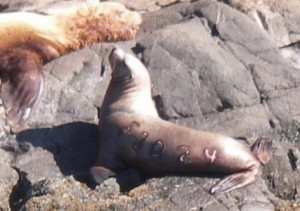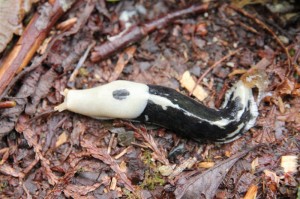
We offer an exceptional fly-in lodge for Grizzly Bear Watching and Whale Watching in British Columbia.
Learn about What’s happening at the Lodge, view our British Columbia’s Wildlife Report, read our Grizzly Bear Watching Blog and Whale Watching Blog. Learn more about a Day on the River Blog, see Our Tour Guide’s Photos & Blog and Photos from Our Guests.

On the lodges grizzly bear tours we often view bears quite close. The viewing stands are located on a narrow road next to Knight Inlet’s Glendale River and after the grizzlies have eaten enough salmon they often pass beneath or very close to the viewing stand. This is the reason we are in an enclosed cage and the bears are free to roam.
This grizzly bear cub because of the size is from late May or early June. The mother grizzlies bring their cubs to this part of Knight Inlet to feed on the beaches and turnover rocks. This inter-tidal zone “food” is high in protein and is made up of crab, clams, barnacles, amphipods and other tiny invertebrates. The “beach food” is important because the only plant food available at this time of the year is the sedge grass. Sedge grass also very high in protein and with inter-tidal zone food it keeps the grizzly bears in good health until the salmon arrive. And no the cub wad not alone on the beach but far enough from mother for a good solo picture. If you click on the photo to enlarge it and then zoom in the cub is not licking anything I can see just sticking out it’s tongue.
“Humpback whales often feed by lunging – moving quickly toward a school of prey with their mouths wide open, then closing their mouths and filtering the salt water out using their baleen. Researchers at the University of British Columbia learned from tagging humpback whales that during these lunges, the whale drops its lower jaw, creating drag that helps fill its mouth with prey and water. The effective, but energetically-costly feeding technique explains the relatively short dives humpback take while feeding.” a quote from Jennifer Kennedy, About.com Guide. Gary Wilson from Australia captures this feeding whale in Blackfish Sound not far from Vancouver Island’s Telegraph Cove. On normal whale watching safari day with an incoming tide to bring the herring into the viewing area we will see several humpbacks feeding.
Fall grizzly bear viewing from our lodge on Knight Inlet takes place on the Glendale River and a man made salmon spawning channel. There are two viewing platforms next to the part of the river the salmon use to pass over a weir into the spawning channel. The second stand we normally use has a deep pool on one side, the natural river on the other two sides leaving the forth for a narrow road. This grizzly, in the deep pool, has it’s eye on us in the stand maybe because we made to much noise or just out of curiosity. At this time of the year a grizzly bears prime concern is food namely pink salmon. Hibernation maybe a little more than two months away and this is the time to “bulk up” for the long winter. A bear without sufficient fat may not survive the winter and in the case of a female it may mean that she will absorb her “eggs” and not proceed with a pregnancy.
Luwen & Liwen from Singapore got a great picture of a grizzly bear on the Glendale River in Knight Inlet eating one of the favourite parts of a salmon it just caught: the eggs or roe. During the peak of the salmon run the bears have access to an abundance of salmon at that time they will eat only the parts highest in calories – the eggs, skin and brains. Salmon roe and skin are also high in fat; grizzlies will often discard the body of the fish, which is left for the eagles. Early is the salmon run the grizzly devour the whole fish to “bulk up” for the coming winter this is also true later in the season for those bears that have not achieved sufficient weight or fat to survive the winter.
 Grizzly Bear Lodge is a remote lodge meaning arrival is by floatplane from Campbell River on Vancouver Island. This is another great photo opportunity as shown by this picture from guest James O’Donoghue. The forty-five minute flight passes over the mostly uninhabited coast except for the fish farm and logging camps. According to the website “Creation Wiki”: “The Banana slug is the 2nd largest slug in the world – the largest in North America. Banana slugs can grow all the way up to 25cm (10inches) in length.” The lodge is located in the southern portion of BC’s the Great Bear Rainforest and a rainforest does encourage everything to grow “big”.
Grizzly Bear Lodge is a remote lodge meaning arrival is by floatplane from Campbell River on Vancouver Island. This is another great photo opportunity as shown by this picture from guest James O’Donoghue. The forty-five minute flight passes over the mostly uninhabited coast except for the fish farm and logging camps. According to the website “Creation Wiki”: “The Banana slug is the 2nd largest slug in the world – the largest in North America. Banana slugs can grow all the way up to 25cm (10inches) in length.” The lodge is located in the southern portion of BC’s the Great Bear Rainforest and a rainforest does encourage everything to grow “big”.
A herring “ball” results when a school of herring is chased to the surface by a predatory fish, ducks or other diving birds. Often the herring balls can be spotted by a large flock of seagulls noisily feeding on the surface. Spotting the gulls feeding is a joy for your guide as the unenviable fate of the herring is to be dinner for a larger mammal meaning humpback whales. As a guide once the herring ball is located the intent is to stop the boat in proximity of the gulls and wait. “Keep your eye on the gulls and as they lift into the air get ready for a picture of a whale lunge feeding”(see tomorrow’s blog) is the directions given to the guests while we wait. James O’Donoghue’s photo captured the mass of the gulls but not the noise they produce. The area for the lodge’s whale watching safari day is Blackfish Sound not far from Vancouver Island’s Telegraph Cove. It is an area known for the abundance of herring and thus popular for salmon fishing which also means orca that feed on the salmon.
Just when you think the grizzly bears you are viewing do not really know that you are there you get one that looks you right in the eye when caught taking a photo. To put a human touch it would be “A little privacy if you don’t mind.” The bears on the lodge’s tour up Knight Inlet tend to ignore our intrusion into their life. In the spring and summer, while they are feeding on the beach they only acknowledge our presence if we get to close. In the fall in the viewing stands on the Glendale River sudden movement, load noises or a cameras flash left on will get their attention. For the most part the grizzly is aware but chooses to ignore. Guest James O’Donoghue from the UK provided this photo.

Just like that our season has come to an end. I would like to thank all of our wonderful guests and staff who made this year a huge success. I am happy to stay that all of our team is planning to return next season. We are actively taking bookings, with dates starting June 1 2025. Hope to see many of you next season.
The wildlife viewing this season was awesome. A couple highlights that come to mind was the shear number of salmon in our local rivers, as well as the abundance of Resident Orca. With salmon returns being so strong this year, we were happy to see bears in excellent condition. By the end of our season most of the bears had packed on a lot of weight and were getting very “picky” about what parts of the salmon they would eat. Hopefully this will translate into more cubs being born this winter. Another positive was the weather conditions. We had enough rain to keep our fire risks low and it made for some excellent wild berries. The bears took full advantage of this, with the berry season extending far past its normal conclusion. This did mean that we had to work hard to find bears during our summer season, (as they were often feeding on the berries deep into the forest), but moving forward it is excellent that they had such an abundant food supply. The Humpbacks also didn’t disappoint, with great numbers and a few new calves returning with their mothers to feed. After a slower year for resident Orca sightings, this season was one of the best that I can remember. In fact as Im writing this the A62 and A23’s are still being spotted in the area by dedicated biologists. Strong numbers of Chinook and Chum salmon are providing them with a steady food source. There are a lot of positive signs and we are hopeful that 2025 will be another great season.
Over the winter and spring we will be doing some repairs and maintenance. We plan on having a new cedar front deck built in time for the 2025 season, as well as new ceilings and paint in parts of the lodge and rooms. Theres always projects on the go.
Felix, Julien, Ryan, Zack and Myself all look forward to welcoming guest in June. See everyone soon.
Angus Reid
Visit our Blog